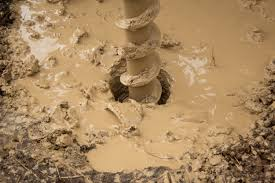Rotary Drilling Fluids - An Overview
Most large holes in large quarries, open pit mines, petroleum extraction, and other industries are drilled using rotary drilling. Rotary cutting can also be used in soft rocks to drill small boreholes. For instance, small holes of 25 millimeters in coal mines are frequently drilled using rotary drilling. In soft rocks, rotary cutting is used, while rotary crushing is used in medium to hard rocks.
Three-cone drill bits with numerous teeth or buttons that freely rotate like planetary gear and crush the rock as the drill bit rotates are the most common bits used in rotary crushing. The weight of the drill rig provides the downward thrust, and the drill pipe's end causes the rotation. A hydraulic or electric motor drives the rotation, typically at speeds ranging from 50 to 120 revolutions per minute.
Cuttings are frequently discharged from the bottom of the hole using compressed air. The flushing of drill cuttings is correlated with the size of the gap that exists between the drill pipe and the hole wall. The drilling speed will decrease if the gap is too small or too big. There is a significant role of drilling fluids involved in this process which we shall explore here.
Functions of Drilling Fluids
The drilling fluid must meet numerous requirements. There must be API 7-2 specifications in the instrument. The primary function of the drilling fluid was to transport cuttings to be removed from the borehole. However, the many uses of the drilling fluids make it difficult to assign specific functions.
The primary functions of the drilling fluid in rotary drilling are to:
1. Cuttings should be carried from beneath the bit, transported up the annulus, and allowed to separate at the surface.
2. Get the bit cool and clean.
3. Reduce friction between the sides of the hole and the drilling string.
4. Maintain the borehole's uncased sections' stability.
5. Stop fluids like oil, gas, or water from entering porous rocks that have been penetrated.
6. Form a thin filter cake with low permeability that closes pores and other openings in formations that the bit has penetrated.
7. Contribute to gathering data from drill cuttings, cores, and electrical logs and interpreting it.
The drilling fluid is restricted or subject to negative requirements due to the functions above.
Some important concerns
The fluid ought to:
1. Not cause harm to drilling personnel or the surrounding environment.
2. Not necessitate unusual or costly methods for closing the drilled hole.
3. Not affect the fluid-bearing formation's normal productivity.
4. Not rust the drilling equipment or cause excessive wear.
Conclusion
Thus we see that the role of drilling fluids in rotary drilling is immensely important. We explored that in detail here.
Resource by: https://bit.ly/3Vsox1Q




Comments
Post a Comment